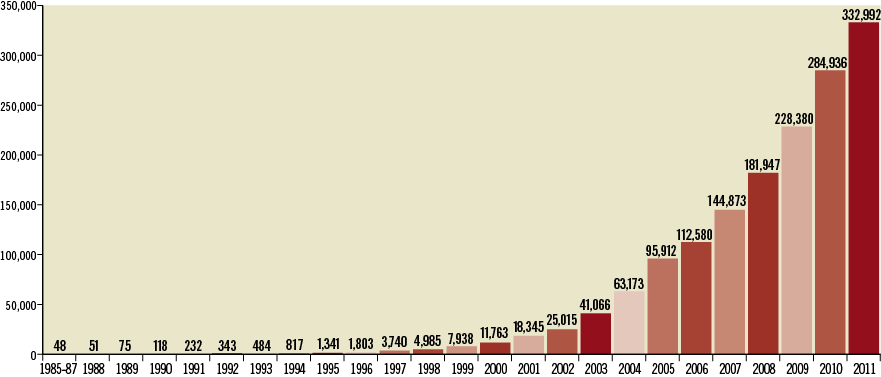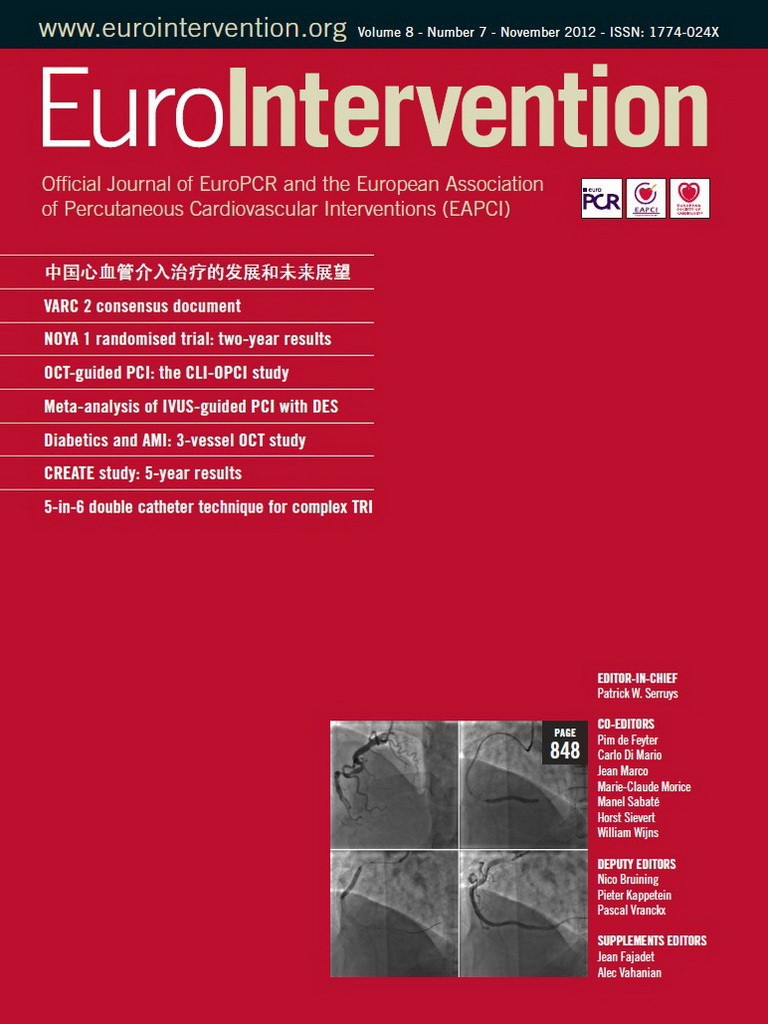Evolution of percutaneous coronary intervention (PCI)
The first percutaneous transluminal coronary angioplasty (PTCA) performed in September 1985 in Xi’an launched a new era for coronary intervention in China.1 Although adoption of interventional cardiology was very slow during the first 10 years with only 11,735 cases being performed in 110 hospitals by 20002, many novel techniques were gradually introduced into China. Rescue PTCA after failure of thrombolysis was introduced in 1989 and direct PTCA to treat acute myocardial infarction or complicating cardiogenic shock in 19903. A few centres also performed coronary excimer laser angioplasty, directional coronary atherectomy and rotational atherectomy. Coronary stenting was introduced in 19924, and drug-eluting stents (DES) in 20015. The last decade has witnessed an exponential growth in the number of cases of coronary artery disease treated by PCI in China (Figure 1)2,6,7. In 2011, a total of 332,992 procedures were performed in 1,053 hospitals, 76% using a transradial approach; the DES penetration rate reached 91.4% with domestically designed and manufactured DES being used in 75% of cases7.

Figure 1. Annual PCI case numbers in China.
Expansion in PCI caseload has been accompanied by an equal expansion in research including: prospective registry studies of new DES8,9; studies on technique and treatment strategies and outcomes of the transradial approach10,11, as well as in the setting of chronic total occlusion (CTO)12,13, bifurcations14 and left main disease15; “real-world” registries focused on left main and complex lesions16-18, and on shortening door-to-balloon time19,20 and prevention of non-reflow21 in acute myocardial infarction; adjunctive antiplatelet therapy following PCI22,23; studies on newly developed DES for regulatory approval24,25, including those with novel biodegradable coatings as well as a stent eluting sirolimus from an abluminal groove filled with a biodegradable polymer (Firehawk); clinical applications of new techniques and devices26,27, such as intravascular ultrasound (IVUS) and fractional flow reserve measurement (FFR); among others. Furthermore, in 1999 the hybrid approach for the treatment of complex multivessel or left main disease was started in Fuwai Hospital28, and randomised trials are on-going.
This issue of EuroIntervention includes original articles which reflect the global relevance of interventional cardiology research which has been conducted in China in recent years. Although during the DES era IVUS-guided DES implantation was documented to optimise stent deployment by identifying stent underexpansion, residual segment stenosis, incomplete stent apposition, edge dissection and stent thrombosis, among other complications, there have been no adequately powered randomised controlled trials confirming its clinical value, and studies on its impact on long-term clinical outcomes have remained controversial. In this issue, Zhang et al reports on a meta-analysis on 19,619 patients comparing IVUS-guided versus angiography-guided DES implantation over a relatively long follow-up period of almost two years. The results showed that IVUS-guided DES implantation was associated with a significant reduction in death (hazards ratio 0.59, 95% confidence interval 0.48-0.73; p<0.001), MACE (0.87, 0.78-0.96; p=0.008) and stent thrombosis (0.58, 0.44-0.77, p<0.001). Although limited by the inclusion of registry studies from diverse settings, lack of adjusted and patient-level data and the presence of data heterogeneity that may among other factors confound the final results, the meta-analysis provides the most robust data thus far on the potential value of IVUS-guided DES implantation. Adequately powered randomised control trials are warranted to confirm the findings from this meta-analysis.
Evolution of interventional treatment of structural heart disease
Rheumatic heart disease was among the most common valvular diseases in China. Mitral valvuloplasty was introduced in China in 1985 and by 2008 a total of 12,644 cases had been performed in 10 major centres. However, in recent years rheumatic heart disease has become rare, as reflected in the dramatic decrease year after year in the number of mitral valvuloplasty cases. With the aging population, the proportion of cases of calcific aortic stenosis has been rising dramatically creating an urgent clinical need for transcatheter aortic valve implantation (TAVI). The first-in-man study of a Chinese-developed modified balloon-expandable transcatheter aortic valve implantation device (Venous A-Valve; Venous Medtech, Hangzhou, China), has been successfully started.
Percutaneous interventional therapy for congenital heart diseases has developed rapidly in China. According to statistics, at least 20,000 cases of congenital heart disease were treated by percutaneous techniques in more than 200 hospitals each year. By June 2012, and over the previous five years, a total of 9,311 cases of ventricular septal defect (VSD) occlusion were performed in 21 major centres with a 96.4% procedural success rate and a 2.6% rate of complications, including 0.09% permanent pacemaker implantation and 0.05% mortality. Chinese modified and manufactured devices have played an important role in the high success and low complication rates for VSD occlusion29.
Future perspective
Great progress has been achieved in China in the field of cardiovascular interventions. In particular, for the treatment of coronary artery disease, the annual PCI case load has dramatically increased over the last 10 years. However, the total numbers of cases achieved today still remains too small to satisfy the local medical needs of a very large population in which the prevalence of coronary artery disease continues to increase. Although the total annual number of PCI cases in China rank as the highest in Asia, the number of PCI procedures per million population is only 218 in China, which is significantly lower than in Japan (1,968 cases), Hong Kong (1,288 cases) or even Malaysia (428 cases). The annual PCI case numbers in China will continue to expand at an estimated 10% increment each year.
Within China, there is dramatic imbalance in terms of PCI development and techniques available in different geographic areas and different hospitals. According to recent statistics in 2011, 53 hospitals performing more than 1,000 PCI cases annually accounted for 32.6% of the total case number for the entire country; 91 hospitals performing 500-999 cases annually accomplished 22.2% of the total case number; while 337 hospitals performing fewer than 100 cases per year accounted for one third of the hospitals that performed PCI7. Therefore, standardisation of training and credentials remains very critical to the continued adequate development of cardiovascular interventions in China. To this end, the Chinese Ministry of Health issued the “Management and Techniques Specifications in Cardiovascular Interventions (2011 edition)”30 which outlines practice standards and training for medical personnel and institutions.
Despite the spurt in the expansion of PCI case numbers achieved in China, research particularly on primary innovation is lagging. Chinese cardiologists welcome opportunities to collaborate more closely with international organisations and colleagues in order to expand clinical evidence, foster material innovations as well as further the research and development of new devices. However, more domestic, large-scale multicentre trials should be conducted to address unsolved or controversial scientific and clinical needs. In recent years, the sciences, technology and industry have also developed rapidly in China, providing the multifaceted capability required for technical innovation and development of new devices. A novel fully bioabsorbable drug-eluting scaffold, an iron bioabsorbable stent, a modified balloon-expandable transcatheter aortic valve implantation device and a novel renal sympathetic denervation device are currently under development. These initiatives are broadly encouraged and supported by the government.
International and domestic academic initiatives are expected to continue to flourish further improving clinical practice, increasing original contributions and ensuring global integration of interventional cardiology in China. I would like to take this opportunity to express my sincere appreciation to the Editor-in-Chief of EuroIntervention, Professor Patrick W. Serruys and to the Editorial Board for the publication of this special issue dedicated to China. This is a great honour for Chinese clinicians and scientists and strengthens the already close and productive collaboration between Chinese and European cardiologists.
Conflict of interest statement
The author has no conflicts of interest to declare.
中国心血管介入治疗的发展和未来展望
高润霖
国家心血管病中心 中国医学科学院 北京协和医学院 阜外医院
经皮冠状动脉介入治疗(PCI)的发展
中国于1985年9月在西安进行了第一例经皮冠状动脉腔内成形术(PTCA),开始了冠心病介入治疗的新纪元。尽管在最初的十几年发展极为缓慢,至2000年全国110多所医院仅完成11753例。在这期间,一些新技术也陆续引入中国,如1989年开始了溶栓后补救性PTCA;1990年开始直接PTCA治疗急性心肌梗死及并发心源性休克;并在少数医院相继开展了激光血管成形术、斑块旋切术、斑块旋磨术;1992年开始冠状动脉支架术治疗;2001年开始了药物洗脱支架(DES)置入术。近十多年来经皮冠状动脉介入治疗(PCI)在中国迅速发展,每年完成例数呈指数增加 (图1)。 至2011年,全国1053所医院进行PCI 332992例,76%经桡动脉途径完成,DES使用率为91.4%,其中75%为国产DES。
PCI例数的巨大增长伴随着研究的活跃。这些研究领域包括新型DES前瞻性注册研究,PCI技术、治疗策略和结果研究,如经桡动脉途径PCI,慢性完全闭塞(CTO)、分支病变(包括左主干)支架治疗方法的改进等,包括左主干等复杂病变在内的大规模真实世界的注册研究,急性心肌梗死缩短就诊—球囊扩张时间、减少无再流的研究,PCI辅助抗血小板治疗研究,中国研发的新型DES(主要包括可降解涂层或单面刻槽内贮可降解涂层西罗莫司支架等)的上市前研究,新技术临床应用研究如血管内超声与血流储备分数测定临床意义的研究等。另外,1999年起阜外医院在国际上较早开始探索杂交技术治疗多支或左主干病变,随机临床试验正在进行中。
本期发表的5篇来自中国医生的论著,反映了近年来中国PCI研究与全球介入心脏病学研究的相关性。虽然在DES时代,已有研究表明IVUS引导的支架置入术通过确定支架不完全扩张、发现局部残余狭窄、支架贴壁不良、边缘撕裂及支架血栓等,使DES置入达到标准化。然而,尚无有足够统计学把握度的随机对照研究确定IVUS引导的DES置入的临床意义。有关IVUS对DES置入远期预后影响的研究结果也仍然是矛盾的。本期?页发表的张等的荟萃分析,在19619患者、在相对较长的随访期内(2年),比较了IVUS引导和造影引导DES置入的临床效果。结果表明,IVUS引导的DES置入可明显减少死亡、MACE和支架血栓发生率。尽管本研究有其局限性,分析是建立在不同条件下的注册登记资料的基础上的,资料未经校正,缺乏患者水平的资料,资料异质性的存在可能影响最终结果。但本荟萃分析提供了迄今为止IVUS引导的DES置入的潜在价值的最有力资料。进行有足够统计学把握度的随机对照试验证实本研究结果是值得的。
结构性心脏瓣膜病介入治疗的发展
风湿性心脏病曾经是中国最常见的瓣膜病,二尖瓣球囊扩张术于1985年在中国开展,据10个最大的中心的统计,至2008年共进行12,644例。但近年来,风湿病已少见,二尖瓣球囊扩张的例数逐年明显减少。随着人口老龄化,退行性主动脉狭窄明显增多,经导管主动脉瓣置入术(TAVI)的开展势在必行。中国自己研发的改良球囊膨胀型经导管主动脉瓣置入装置(Venous A-Valve, 杭州,启明公司)的人体临床试验已成功开展。
先天性心脏病的经皮介入治疗在中国发展较快,据统计目前至少200所医院每年进行经皮先心病治疗20,000例以上。至2010年6月,在21所主要医院5年内完成的9311例室间隔缺损(VSD)封堵术中,手术成功率96.4%,并发症发生率2.6%,其中永久性起搏器置入术0.09%,死亡率0.05%,国产器械的研制和改进对保持VSD封堵术的高成功率和低并发症发生率起了重要作用。
展望
中国心血管介入治疗领域取得了长足发展,尤其近十几年PCI病例数大幅度增加,但显然仍不能满足冠心病患率仍在增加的庞大的患者群的需求。目前中国PCI总量在亚洲最多,但按每百万人口平均PCI数计仅为218例,远低于日本(1968例)、我国香港(1288例)甚至马来西亚(428例)。在今后若干年内,中国的PCI病例数估计仍将以每年10%左右速度增加。
当前中国的PCI技术在不同地区,不同医院发展极不平衡,据2011年统计,每年完成1000例以上的医院只有53家,却完成了全国总病例数的32.6%;每年完成500-999例的91家完成总病例数的22.2%;但仍有年病例数不足100例的医院337家,占全部医院的1/3。因此,规范化技术培训和资格认证至关重要。为此,中国卫生部发布“心血管疾病介入治疗技术管理规范(2011)”,对从事介入治疗的医生、医疗机构技术准入条件、培训标准和培训基地进行了严格的规范,对保持中国介入心脏病学持续稳定健康发展将起到十分重要的作用。
中国尽管PCI数量取得突飞猛进的发展,但研究工作尤其原始创新相对落后。中国心内科医生希望有机会更加密切地与国际学术组织或同道合作,扩展临床证据、加速材料创新及新器械研发。并针对当前尚未解决或尚有争议的科学或临床问题更多地组织国内大规模多中心临床试验。中国的的科学、技术及工业近年来发展迅速,提供了技术创新和新器械研发所必需的多学科合作的能力和条件。最近,新型DES多聚物全降解药物洗脱模架、全降解铁支架,改良球囊膨胀型经导管主动脉瓣置入装置及新型肾动脉交感神经消融装置的研发,都是在政府的强力支持下进行的。
国际、国内学术交流必须继续加强,以进一步提高临床实践水平和原创性,促进中国的介入心脏病学进一步发展,并更紧密地融合在国际介入心脏病学大家庭中。我想藉EuroIntervention出版中国专辑之际 向主编Patrick Serruys教授及编辑部表示最诚挚的谢意。这是中国临床医生和科学家的荣誉,也必将使中欧心内科医生之间业已存在的紧密而卓有成效的合作进一步加强。
References

